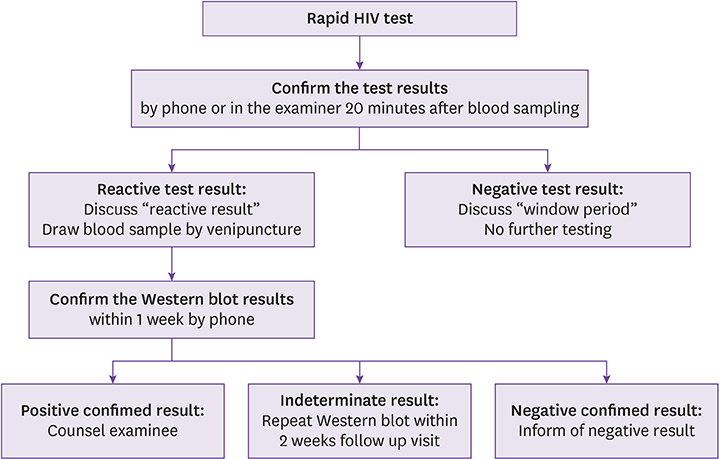Infect Chemother.
2018 Dec;50(4):346-349. 10.3947/ic.2018.50.4.346.
Implementing Expanded Rapid Human Immunodeficiency Virus Testing in Public Health Centers in Seoul, 2015
- Affiliations
-
- 1Environmental Health Division, Seoul Metropolitan Government, Seoul, Korea.
- 2Division of Infectious Diseases, Seoul Metropolitan Government - Seoul National University Boramae Medical Center, Seoul, Korea. roundbirch@gmail.com
- 3Seoul Center for Infectious Disease Control, Seoul, Korea.
- 4Department of Epidemiology, Seoul National University Graduate School of Public Health, Seoul, Korea.
- 5Department of Internal Medicine Seoul National University College of Medicine, Seoul, Korea.
- 6Department of Family Medicine, Seoul National University College of Medicine, Seoul, Korea.
- KMID: 2429938
- DOI: http://doi.org/10.3947/ic.2018.50.4.346
Abstract
- In 2015, rapid human immunodeficiency virus (HIV) testing was implemented in all 25 public health centers in Seoul. During March and December 2015, 20,987 rapid HIV tests were performed, of which 116 (0.5%) were positive. Compared to those of the period before application of the rapid HIV test in place of conventional enzyme immunoassay method, the number of HIV tests performed and the number of positive results increased by sevenfold and twofold, respectively. In conclusion, expansion of the provision of rapid HIV tests in public health centers increased the number of voluntary HIV tests.
Figure
Reference
-
1. Lee JH, Kim GJ, Choi BS, Hong KJ, Heo MK, Kim SS, Kee MK. Increasing late diagnosis in HIV infection in South Korea: 2000-2007. BMC Public Health. 2010; 10:411.
Article2. Kang CR, Bang JH, Cho SI, Kim KN, Lee HJ, Ryu BY, Cho SK, Lee YH, Oh MD, Lee JK. Patients presenting with advanced human immunodeficiency virus disease: epidemiological features by age group. J Korean Med Sci. 2016; 31:178–182.
Article3. Dennis AM, Napravnik S, Seña AC, Eron JJ. Late entry to HIV care among Latinos compared with non-Latinos in a southeastern US cohort. Clin Infect Dis. 2011; 53:480–487.
Article4. Pilcher CD, Price MA, Hoffman IF, Galvin S, Martinson FE, Kazembe PN, Eron JJ, Miller WC, Fiscus SA, Cohen MS. Frequent detection of acute primary HIV infection in men in Malawi. AIDS. 2004; 18:517–524.
Article5. San Antonio-Gaddy M, Richardson-Moore A, Burstein GR, Newman DR, Branson BM, Birkhead GS. Rapid HIV antibody testing in the New York state anonymous HIV counseling and testing program: experience from the field. J Acquir Immune Defic Syndr. 2006; 43:446–450.6. Gilbert M. Impact and use of point of care HIV testing: a public health evidence paper. BC Centre for Disease Control, STI/HIV. Prevention and Control. 2007.7. Kang CR, Bang JH, Cho SI, Kim KN, Lee HJ, Lee YH, Ryu BY, Cho SK, Oh MD, Lee JK. Implementing the use of rapid HIV tests in public health centers in Seoul: results of a pilot project, 2014. J Korean Med Sci. 2016; 31:467–469.
Article8. World Health Organization (WHO). HIV assays: operational characteristics (phase 1). Report 14. Simple/rapid tests. Geneva, Switzerland: WHO;2004.9. Patel P, Bennett B, Sullivan T, Parker MM, Heffelfinger JD, Sullivan PS. CDC AHI Study Group. Rapid HIV screening: missed opportunities for HIV diagnosis and prevention. J Clin Virol. 2012; 54:42–47.
Article10. Mimiaga MJ, Reisner SL, Bland S, Skeer M, Cranston K, Isenberg D, Vega BA, Mayer KH. Health system and personal barriers resulting in decreased utilization of HIV and STD testing services among at-risk black men who have sex with men in Massachusetts. AIDS Patient Care and STDS. 2009; 23:825–835.
Article11. Marks G, Crepaz N, Senterfitt JW, Janssen RS. Meta-analysis of high-risk sexual behavior in persons aware and unaware they are infected with HIV in the United States: implications for HIV prevention programs. J Acquir Immune Defic Syndr. 2005; 39:446–453.
Article
- Full Text Links
- Actions
-
Cited
- CITED
-
- Close
- Share
- Similar articles
-
- Diagnosis of Human Immunodeficiency Virus Infection
- Identifying Barriers to Human Immunodeficiency Virus Testing for Men Who Have Sex with Men in South Korea
- A Case of Ankylosing Spondylitis in a Patient with Human Immunodeficiency Virus
- Update on Laboratory Testing for Diagnosing HIV Infection
- Modification of AxSYM Human Immunodeficiency Virus Assay to Identify Recent Human Immunodeficiency Virus Infections in Korean Human Immunodeficiency Virus-Positive Individuals


